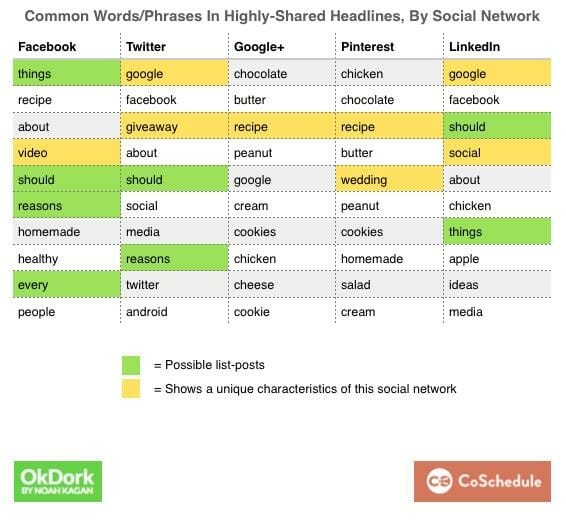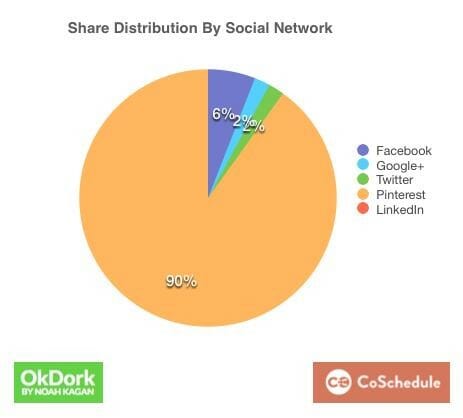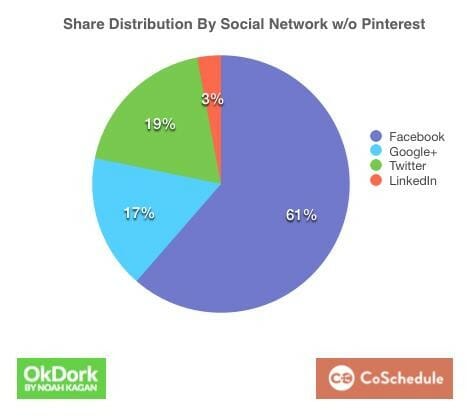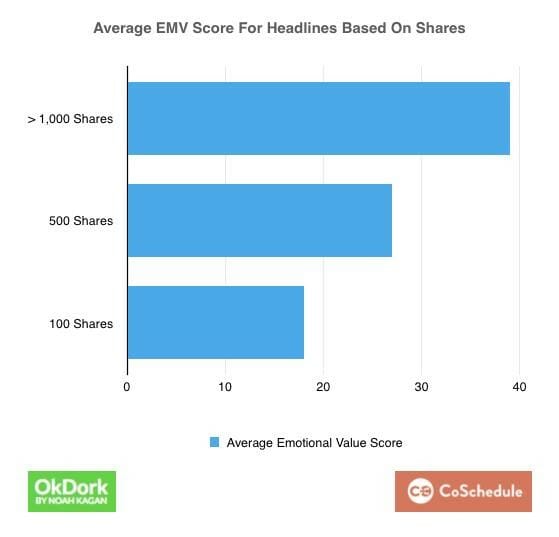This is guest post by Garrett Moon, Founder at CoSchedule
Here at CoSchedule, we help our customers plan their blog and social media content on a single drag and drop calendar. This is cool, but what it really means is that we have access to a ton of data about blog headlines, including where those headlines get shared online.
After reaching nearly 1 million blog post headlines in our system, we began wondering about what they could reveal about growing traffic and writing better headlines. Specifically, we wondered:
What is it that makes one headline more shareable than another?
The Data
For the purposes of this post, we began with a dataset of nearly 1 million headlines. I trimmed that number down to English-only posts that had already been published. Then I whittled it down further to a group of headlines that had received at least 100 total shares across all of the major social networks.
From there, I created another group of headlines that had more than 1,000 shares. This lead to my first major insight.
Most content doesn’t get shared all that much.

Just let this chart sink in for a minute. This means that 89% of the content that is created is never shared more than 100 times! Besides coming off as a bit depressing, this should be major motivation for you to do things differently.
In this post, I am going to specifically focus on the headlines that fell in the top 11% of these results. You are going to see what makes high performing headlines work, so that you can apply the ideas to your own content and put yourself in the top-tier of high-performing blogs.
What common words/phrases are used in highly-shared headlines?

To start, I went through a few common words and phrases used in headlines that were shared more than 1,000 times. The results were telling.
Takeaway #1 – List Posts Are Huge
One of the first things that I saw was that lists posts are huge and were the most likely type of post to be shared more than 1,000 or even 100 times. More interestingly, list posts only made up 5% of the total posts actually written, which means that we don’t create enough of these posts to begin with. An immediate takeaway here is to start creating more list posts.
Takeaway #2 – Use ‘You’ & ‘Your’ A Lot
Posts that used words like ‘you and your’ in their headline performed extremely and were shared frequently. In contrast, posts that used ‘I and Me’ we three times less likely to be shared. This suggests content that written in the second person – the point of view you take when you are speaking directly to the reader – is far more likely to be shared than content that comes from a first person narrative. Obviously, readers like to see themselves in what they are reading.
Takeaway #3 – Help Your Readers Imagine A Better Life
People really like content that helps they do something awesome, like win something for free or learn something new. We can easily see this in the frequent occurrence of words like ‘free,’ ‘giveaway,’ and ‘how to.’ Use promising words to your readers, and that will make them more likely to share your content with others.
How do common headline words change based on social network?
I wanted to see how the frequency of keywords changed in the headlines when they were broken down by social network. I was pretty surprised by the results.
Fact: Both Facebook and Google+ are surprisingly home-oriented, with top words like ‘recipe’ and ‘homemade.’ Twitter on the other hand tends to be more business and technology focused.

Takeaway #4 – List-posts Do Best On Facebook, Twitter, and LinkedIn
We already know that list posts get shared like crazy, but which networks reward them the most? In a list of some of the most common terms for used on network, there were several words that seemed to indicate the use of a list-based post. On Facebook, Twitter, and LinkedIn, for example, word’s like ‘thing, should, and reasons’ seem to clearly indicate the use of a list.
You can easily imagine the corresponding headlines.
- 5 Things You Can Do To Write Better Headlines
- 4 Reasons You Should Wash Your Hair Every Day
- 8 Things Every Mom Says To Her Kids
Interestingly, these list-like terms are also highly emotional terms, a strong signal that the data will touch on more about bit later.
Takeaway #5 – Video Is Most Popular On Facebook
Facebook was absolutely the most popular network featuring video content, and the only network that had the word included in its top headlines. This likely has something to do with the way that Facebook itself embeds videos directly in the news feed.
Takeaway #6 – Customize Headlines For Each Social Network
Each network has its own audience and demographic and should be catered to individually. For example, in our results, Facebook and Pinterest tended to be home-oriented, whereas Twitter and LinkedIn tended to stay more business focused. Different audiences require different types of content.
One way to accommodate this would be to write custom headlines for each social network that caters to the specific audience rather than just sharing the same old post title on each network. We try to make this type of social sharing as easy as possible with CoSchedule because we know how important it can be.
Where do the world’s most popular headlines get shared?
Part of understanding how shareable headlines work comes from understanding how users will be sharing our content. When we took a look at which social networks were contributing the most shares, the results were pretty astounding. Pinterest totally killed it.

Takeaway #7 – Pinterest Offers HUGE Shares If You Can Reach The Audience
Among headlines shared more than 1,000 times, Pinterest commanded an astounding 90% of total shares. This simply blew my mind. Pinterest is huge! Of course, you have to have the right type of content to scale this network (see above), but it is ripe for the picking if you know how to do it.

Takeaway #8 –At The End Of The Day, It’s Hard To Beat Facebook
Once Pinterest is removed from the scenario, Facebook comes away as the most popular network for social sharing. In their epic slide deck The Sweet Science Of Virality, Upworthy also makes this claim. If you want big shares, Facebook and Pinterest seem to be where it’s at.
* * *
Can you predict the popularity of a headline? (YES!)
Digging in a little more, I wanted to see if there was an easy way to “rate” a headline and essentially predict (as best I can) if it is going to be a well shared post or not.
To figure this out, I started testing some of the most well-shared headlines using the Emotional Marketing Value Headline Analyzer as made available by the Advanced Marketing Institute. This handy little tool promises to tell you how “emotional” your headline is by counting the number of emotional words that are used in the phrase.

The headline analyzer is easy to use. Simply copy/paste your headline into the box and will give you a calculated score of your headline’s EMV Score. Here is the result for the headline of this post:

Here’s how the headlines analyzer works:
This score indicates that your headline has a total of 30.00% Emotional Marketing Value (EMV) Words. To put that in perspective, the English language contains approximately 20% EMV words.
And for comparison, most professional copywriters’ headlines will have 30%-40% EMV Words in their headlines, while the most gifted copywriters will have 50%-75% EMV words in headlines.
A perfect score would be 100%, but that is rare unless your headline is less than five words.
So, the question is: does it really work as a way to predict popularity? To test, I took an average sampling of headlines in three different sharing groups.
- Posts with greater than 1,000 shares
- Posts with 500 shares
- Posts with 100 shares
Here were the results:

Posts with a high number of shares frequently reached an EMV Score of 30 or 40, several points higher than posts with fewer shares.
HUGE Takeaway #9 – Emotional Headlines Get Shared More
What I found was that as the number of shares also increased, so did the EMV score of the headline. This means that headlines with a higher EMV Score are more likely to be shared more that posts with a lower EMV Score. Essentially, there is a direct link between the number of emotional words used in a headline and the likelihood it will be shared more than 1,000 times. This is a HUGE takeaway that we can all put to work on our posts right away.
Of course, I wanted to verify my data on this one, since it is such a huge point. I wondered: what would happen if I compared the 5 most shared and the 5 least shared posts on some of the world’s most popular blogs? Would the EMV Score continue to be a good indicator of sharing?
The answer is yes.

Takeaway #10 – You Can Easily Quantify The Emotional Value Of A Headline
On three of the most highly shareable blogs out there, the posts with more shares had, on average, a higher EMV Score than those posts with fewer shares. Wow! Based on these results, we should all be shooting for an EMV headline value of around 30 or above.
Of course, an EMV of 40 or more will significantly improve our chances of getting more than 1,000 shares for our post, as indicated from the results above.
* * *
At the end of the day, your headline will make a huge difference in the number of shares that a post receives, but there are several things that we can do to help ‘manufacture’ that virility. A good way to start, might be by analyzing the average EMV Score for some of your most popular posts. You can use this handy method to gather the data that you need for free. You can also take a look at this post, which takes a similar look at extremely viral headlines.
Bonus Takeaway #11 – Get A Free Mega-Trial of CoSchedule!
For 1 person who comments, they’ll get a lifetime premium plan to CoSchedule.
For OkDork readers, they are offering an exclusive (and free) 45 day mega-trial of CoSchedule starting right away. It is a pretty great place to put some of the things in this post into practice, so give it a try.
Garrett Moon is a founder at CoSchedule, a WordPress editorial calendar that allows you to schedule your blogs posts and social media together on an easy drag-and-drop calendar. Follow him on Twitter or Google+.

209 responses to “What We Learned Analyzing 1 Million Blog Headlines”
Your post gave so many valuable insights. Thank you.
That article is sensational and extremely valuable since there are many useful tips to help our content be noticed.
I have 2 youtube channels and been following powtoon etc. I need to reach 1000 subs and 4000 watch hours and it seems impossible your website has helped
Really insightful, thanks!
This is very interesting and awesome. I have gained immensely from your wealth of experience
That EMV is amazing tool! Combined with your headline analyzer is big help for writing bulletproof headlines?
Excellent article and a great topic to learn about.
Anything we can learn about what drives people and how they react is well worth studying.
Also, coschedule rocks
Is this useful for native languages also like HINDI or BANGLA
Thank you so much for the diligence in providing this information!
Very interesting! This could definitely help me out with my new career!
Thank you!
Wow, that is extremely interesting. A very few observations I had made myself already, such as that everybody use “How to…” so I did the same. But what is difficult for me, I am a project manager and that’s what I want to write about. So, how do I write an emotional headline now?
Do you have one for blogger blogs?
Informative and useful information.!
Hi Garrett! I am just starting my social media marketing for our company, Mighty Morsels for Dogs. Your article is extremely helpful as I like to get right to the best of the best, saving me precious time, which you have done so completely. I am excited now, rather than apprehensive, that I am successful in this area of communicating with my Tribe. Many thanks and blessings.
I’m a new blogger from an engineering background so a lot of the terminology is foreign to me. In addition to starting a new small business, I think blogging will bring new income sources so I am open to look at anything within my tight budget.
2017-07-26T10:15:47Z When will the next update be? I ask due to the rapid way that things change.
Great info, thx! FWIW, something to consider in your analysis: Women, as a gender, are statistically more likely to seek and share information (more so than men). The dominance of female users of Pinterest (81%+) in particular–and therefore analysis of shares, of which your data show Pinterest excels) may be biasing your results, particularly in comparison to impact of EMV score and, say, LinkedIn posts. 56% of users of LI are male. Just a thought. Mary Anne Graf, author of
The Complete Guide to the Women’s Health Service Line Marketing (HCPro)
Awesome read. I use both these analyzers. I knew that there was something to these tools but just didn’t have the data to back up my assumptions. Thanks for the info
A great article for anyone who needs to become a good writer in their work. We all know headlines must be good, and anything that can help us develop the skill to use them well is a boon. I’m intending to use the tools recommended here to shorten the learning curve, as well as validating my own assessments regarding my headlines.